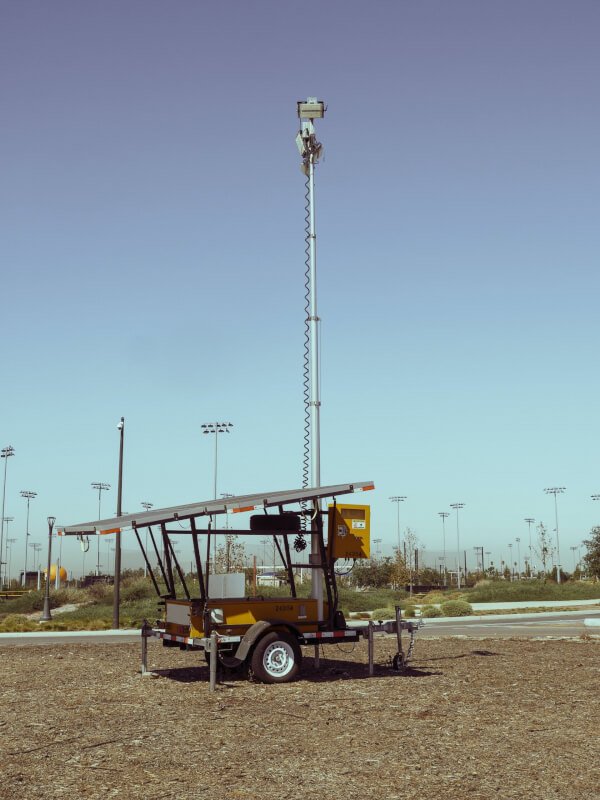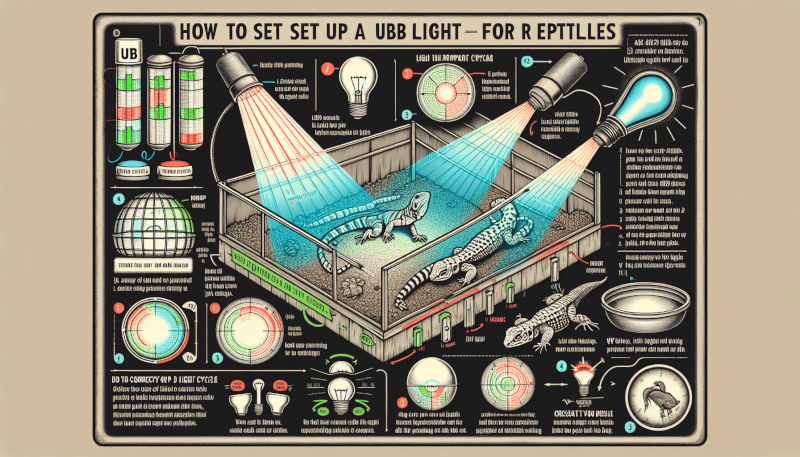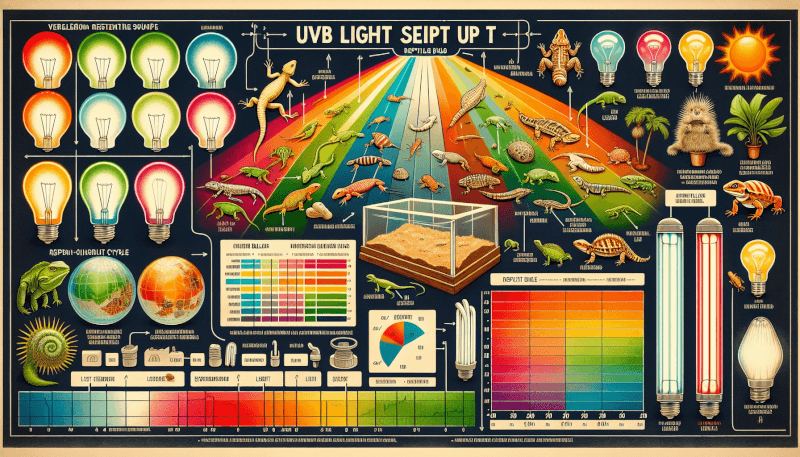Are you a reptile owner looking to ensure the health and well-being of your scaly friend? One crucial aspect to consider is providing proper lighting, specifically a UVB light. In this article, we will guide you through the steps needed to set up a reptile UVB light correctly, helping you create an environment that mimics their natural habitat and promotes their overall health. From choosing the right type of bulb to determining the appropriate distance and duration of exposure, we’ve got you covered. So let’s get started on creating a happy and healthy home for your reptilian companion!

Choosing the Right UVB Light
Understanding the Importance of UVB Light for Reptiles
When it comes to keeping reptiles as pets, providing them with the proper lighting is crucial for their health and well-being. Reptiles, such as lizards and turtles, require UVB light in order to produce Vitamin D3, which is essential for calcium metabolism. UVB light also helps stimulate natural behaviors, maintain proper immune function, and promote overall physiological well-being. Therefore, choosing the right UVB light is of utmost importance to ensure your reptile’s optimal health.
Different Types of UVB Lights
There are several types of UVB lights available in the market, including fluorescent tube lights and compact coil bulbs. Fluorescent tube lights are a popular choice for larger enclosures as they provide a wider coverage area. On the other hand, compact coil bulbs are more suitable for smaller enclosures. It is important to choose a UVB light that matches the specific needs of your reptile’s species and habitat.
Considerations for Your Reptile’s Species and Habitat
Different reptile species have different requirements when it comes to UVB lighting. While some reptiles may require a higher UVB output, others may require a lower output. It is essential to research and understand the specific lighting needs of your reptile’s species and replicate their natural habitat conditions as closely as possible. Factors such as the reptile’s native environment, activity levels, and basking habits should all be taken into consideration when choosing the right UVB light.
Determining the Right UVB Output
The UVB output of a light source is measured in terms of UVB percentages or wavelengths. It is important to determine the appropriate UVB output for your reptile to ensure they receive the right amount of UVB light. Too little UVB exposure may lead to a deficiency in Vitamin D3, while too much exposure can cause overexposure and potential harm to your reptile. Consulting with a veterinarian or experienced reptile keepers can help you determine the right UVB output for your specific reptile’s needs.
Positioning the UVB Light
Location within the Terrarium
The placement of the UVB light within the terrarium is crucial for your reptile’s health. Generally, it is recommended to position the UVB light on the top of the enclosure to mimic the natural sunlight that reptiles receive in the wild. Placing the light on top allows for better UVB penetration and ensures that your reptile is exposed to the light from above, just like they would be in their natural habitat.
Proper Height and Distance from the Reptile
The height and distance at which the UVB light is positioned is also important. You want to ensure that your reptile is receiving the optimal amount of UVB light without being too close or too far away from the light source. The specific recommended height and distance may vary depending on the specific UVB light and the species of your reptile. It is recommended to follow the manufacturer’s guidelines or consult with a reptile expert to determine the appropriate height and distance for your setup.
Avoiding Obstacles and Shadows
When positioning the UVB light, it is crucial to avoid any obstacles or objects that may obstruct the light from reaching your reptile. Obstructions such as branches, plants, or decorations can cast shadows and prevent your reptile from receiving adequate UVB exposure. It is important to ensure that the light is unobstructed and reaches all areas of the enclosure, providing a consistent source of UVB for your reptile.
Preventing Overexposure to UVB
While UVB light is essential for reptile health, overexposure can also be harmful. Reptiles in the wild naturally regulate their exposure to UVB light by seeking shade or moving away from direct sunlight when necessary. In a captive environment, it is important to simulate this natural behavior and provide areas of shade within the enclosure. This can be achieved by creating hiding spots or providing structures that allow your reptile to move away from the UVB light when they’ve had enough exposure.

Installing the UVB Light
Choosing the Right Fixture
Selecting the appropriate fixture for your UVB light is essential to ensure its proper installation and operation. Different types of UVB lights may require specific fixtures, so it is important to choose one that is compatible. Some fixtures may offer additional features such as adjustable height or built-in reflectors, which can enhance the effectiveness of the UVB light. Take into consideration the size of your enclosure, the specific needs of your reptile, and the guidelines provided by the UVB light manufacturer when selecting a fixture.
Mounting Options for UVB Lights
There are a few different mounting options available for UVB lights, each with its own advantages. One common method is to use a bracket or suction cup to attach the fixture directly to the terrarium. This option allows for easy adjustment and repositioning of the light. Another mounting option is to use a hanging kit, which suspends the light from the top of the enclosure. This method is particularly useful for larger enclosures where a single fixture may not provide adequate coverage. Consider the size and layout of your terrarium when choosing the appropriate mounting option.
Securing the Fixture in the Terrarium
Once you have chosen the right fixture and mounting option, it is important to securely install it in the terrarium. Make sure all connections are tight and secure to prevent any accidents or damage to the fixture. Double-check that the fixture is stable and won’t fall or be dislodged by your reptile’s movements. If using a hanging kit, ensure that it is properly anchored and can support the weight of the UVB light. The safety and well-being of your reptile should always be the top priority.
Wiring and Electrical Safety Measures
When installing the UVB light, it is important to follow proper electrical safety measures. Ensure that the fixture and any extension cords used are in good condition and are rated for the appropriate wattage. Avoid overloading electrical outlets and ensure that the wiring is not exposed or within reach of your reptile. It is also recommended to use a surge protector to protect against power surges and voltage fluctuations. If you are unsure about electrical installation, it is best to consult with an electrician to ensure that everything is installed safely and correctly.
Managing UVB Light Exposure
Understanding Photoperiods
In addition to proper UVB exposure, reptiles also require consistent and appropriate photoperiods, which refer to the light and dark cycle they experience in a 24-hour period. Replicating natural lighting conditions is essential for the overall health and behavior of your reptile. Photoperiods help regulate their circadian rhythm, reproductive cycles, and overall physiological functions. It is important to understand the specific lighting requirements of your reptile’s species and provide the appropriate light and dark cycles.
Maintaining a Consistent Light Cycle
To maintain a consistent light cycle, it is recommended to use a timer to control the duration of UVB light exposure. The timer can be set to turn the UVB light on and off at specific times, ensuring that your reptile receives the appropriate amount of light each day. It is important to maintain consistency in the light cycle to mimic the natural lighting conditions your reptile would experience in the wild.
Adjusting Photoperiods for Seasonal Changes
In the wild, reptiles experience changes in light and dark cycles with the changing seasons. It is important to replicate these seasonal changes in photoperiods to mimic the reproductive and physiological responses of your reptile. Adjusting the light cycle duration or intensity during certain seasons can help promote natural behaviors and ensure the overall well-being of your reptile. Research the natural habitat of your reptile’s species and consult with a veterinarian or reptile expert for guidance on adjusting photoperiods.
Monitoring and Regulating UVB Output
Regular monitoring of the UVB output is essential to ensure that your reptile is receiving adequate exposure. UVB lights can lose their effectiveness over time, so it is important to periodically check the output using a UVB meter. This will help you determine when it’s time to replace the UVB light. Additionally, it is important to regulate the distance and height of the UVB light to avoid overexposure. Adjustments may be necessary if you notice any signs of overexposure or deficiency in your reptile.

Replacing UVB Lights
Lifespan of UVB Lights
UVB lights have a limited lifespan, and their effectiveness diminishes over time. It is important to replace them at the appropriate intervals to ensure that your reptile continues to receive the necessary UVB exposure. The lifespan of UVB lights can vary depending on the brand and type, so it is recommended to refer to the manufacturer’s guidelines for replacement intervals. As a general guideline, most UVB lights should be replaced every 6 to 12 months.
Monitoring UVB Output Decay
Over time, UVB lights may lose their potency and output, even before the end of their recommended lifespan. It is important to monitor the UVB output regularly using a UVB meter to ensure that your reptile is still receiving adequate exposure. If the UVB output drops significantly below the recommended levels, it may be necessary to replace the UVB light sooner than expected. Regular monitoring will help you catch any decline in UVB output and take appropriate action.
Replacing UVB Lights at the Right Time
Knowing when to replace your UVB light is crucial for maintaining your reptile’s health. As mentioned earlier, it is generally recommended to replace UVB lights every 6 to 12 months. However, it is important to monitor the UVB output and the overall condition of the light to determine if replacement is needed sooner. If you notice any signs of deficiency or if the UVB output is significantly reduced, it is best to replace the light promptly to ensure your reptile’s well-being.
Proper Disposal of Old UVB Lights
When it comes to disposing of old UVB lights, it is important to handle them with care. UVB lights contain small amounts of mercury, which is hazardous to both humans and the environment. Contact your local waste management or recycling facility to inquire about the proper disposal methods for UVB lights. They will be able to provide you with instructions on how to safely dispose of the old lights in an environmentally friendly manner.
Cleaning and Maintaining UVB Lights
Cleaning the Fixture and Bulb
Regular cleaning of the UVB light fixture and bulb is important to ensure their effectiveness and prolong their lifespan. Gently wipe down the fixture and bulb with a soft, lint-free cloth to remove any dust or debris that may accumulate over time. Avoid using harsh chemicals or abrasive materials that may damage the fixture or bulb. By keeping the UVB light clean, you can ensure that your reptile is receiving the optimal amount of light and UVB exposure.
Removal of Dust and Debris
Dust and debris can accumulate on the surface of the UVB light, reducing its effectiveness. Regularly inspect the light and remove any dust or debris that may have settled on it. You can use a soft brush or a can of compressed air to remove the dust. This will help maintain the UVB output and ensure that your reptile is receiving the appropriate UVB exposure.
Replacing Protective Covers
Some UVB light fixtures come with protective covers or screens to prevent your reptile from directly accessing the light source. Over time, these covers may become damaged or dirty, obstructing the UVB light and diminishing its effectiveness. It is important to periodically inspect these covers and replace them if necessary. A clean and undamaged protective cover will help ensure that your reptile is receiving the proper UVB exposure while also keeping them safe from potential harm.
Regular Inspection and Maintenance
In addition to regular cleaning, it is important to regularly inspect the UVB light fixture and bulb for any signs of wear or damage. Check for loose connections, cracks, or any other issues that may affect the performance of the UVB light. Performing regular maintenance and addressing any issues promptly will help ensure that your reptile receives the proper UVB exposure and minimize the risk of accidents or malfunctions.

UVB Light and Vitamin D3
Understanding Reptile Vitamin D3 Production
Vitamin D3 is crucial for the health and well-being of reptiles as it helps regulate calcium metabolism and bone development. Reptiles have the unique ability to produce Vitamin D3 in their skin when exposed to UVB light. This is why providing adequate UVB light is essential for reptiles kept as pets. Without sufficient UVB exposure, reptiles may experience Vitamin D3 deficiency, leading to health problems such as metabolic bone disease.
The Role of UVB Light in Vitamin D3 Synthesis
UVB light plays a vital role in the synthesis of Vitamin D3 in reptiles. When reptiles are exposed to UVB light, a chemical reaction occurs in their skin that converts a precursor molecule into active Vitamin D3. This active Vitamin D3 is then used by the reptile’s body to regulate calcium absorption and maintain healthy bones and organs. Therefore, proper UVB exposure is crucial to ensure that your reptile can produce enough Vitamin D3 for their physiological needs.
Balancing UVB Exposure for Adequate Vitamin D3 Levels
Finding the right balance and duration of UVB exposure is important for maintaining adequate Vitamin D3 levels in reptiles. Too little UVB exposure can lead to Vitamin D3 deficiency, while excessive exposure can cause overproduction and potential toxicity. It is important to follow the manufacturer’s guidelines and consult with a reptile expert or veterinarian to determine the appropriate duration of UVB exposure for your specific reptile’s species. Achieving the right balance will help ensure that your reptile maintains optimal Vitamin D3 levels for good health.
Supplementing with Vitamin D3 if Needed
In some cases, despite providing the proper UVB lighting, reptiles may still experience Vitamin D3 deficiency. This may be due to factors such as the reptile’s inability to adequately absorb or utilize UVB light. In such cases, it may be necessary to supplement with additional Vitamin D3. Consult with a veterinarian who is experienced in reptile care to determine if Vitamin D3 supplementation is necessary and to ensure that the dosage is appropriate for your reptile’s needs.
Monitoring Reptile Behavior and Health
Observing for Signs of UVB Exposure Issues
Regular monitoring of your reptile’s behavior and health is essential to ensure that they are receiving the proper UVB exposure. Observe your reptile for any signs of UVB exposure issues, such as decreased appetite, lethargy, or changes in behavior. A reptile that is not receiving adequate UVB exposure may show signs of metabolic bone disease, such as soft or malformed bones, muscle weakness, or difficulty in movement. Promptly addressing any signs of UVB exposure issues can help prevent further health complications.
Skin and Eye Health Indicators
The condition of your reptile’s skin and eyes can also indicate their UVB exposure and overall health. Reptiles that are receiving sufficient UVB exposure will often have healthy, vibrant skin and clear, bright eyes. On the other hand, reptiles with UVB deficiency may exhibit signs such as skin darkening, shedding problems, abnormal coloration, or eye issues like cloudiness or swelling. Regularly inspect your reptile’s skin and eyes to ensure that they are in good health and seek veterinary attention if you notice any abnormalities.
Behavioral Changes and Sunlight Interaction
UVB exposure not only affects your reptile’s physical health but also their behavior. Reptiles that are receiving the appropriate amount of UVB light will exhibit natural behaviors such as basking, exploring their enclosure, and engaging in physical activities. On the other hand, reptiles with insufficient UVB exposure may become lethargic, hide away from the light, or display abnormal behaviors. Pay attention to your reptile’s behavior and ensure that they have access to the appropriate UVB light to promote their natural behaviors and overall well-being.
Consulting a Veterinarian for Concerns
If you have any concerns about your reptile’s behavior or health, it is always best to consult with a veterinarian who specializes in reptile care. They can provide valuable insight, diagnose any potential issues, and offer appropriate treatment options. Regular veterinary check-ups are also important to ensure that your reptile is in good health and to address any potential problems before they become more serious.

Common Mistakes to Avoid
Insufficient UVB Output
One common mistake many reptile owners make is providing insufficient UVB output. It is important to ensure that the UVB light you choose matches the specific needs of your reptile’s species and habitat. Insufficient UVB exposure can lead to Vitamin D3 deficiency, which can have serious health implications for your reptile. Research your reptile’s specific lighting needs and consult with experts to ensure that you are providing the appropriate UVB output.
Improper Positioning and Inadequate Coverage
Another common mistake is improper positioning of the UVB light or inadequate coverage within the terrarium. It is important to position the light on the top of the enclosure, at the appropriate height and distance, to ensure optimal UVB exposure for your reptile. Additionally, it is crucial to avoid any obstructions or shadows that may hinder the UVB light from reaching your reptile. Providing proper positioning and adequate coverage will ensure that your reptile receives the necessary UVB light throughout the enclosure.
Ignoring Maintenance and Replacements
Maintaining and replacing UVB lights regularly is often overlooked by reptile owners. As mentioned earlier, UVB lights have a limited lifespan and their effectiveness diminishes over time. Neglecting to replace them at the appropriate intervals can lead to inadequate UVB exposure and potential health issues for your reptile. Similarly, regular cleaning and inspection of the UVB light fixture and bulb are crucial for their optimal performance. It is important to prioritize maintenance and replacement to ensure your reptile’s health and well-being.
Neglecting to Monitor Reptile Behavior and Health
Not closely observing your reptile’s behavior and health can lead to missed signs of UVB exposure issues or other health concerns. Regularly monitor your reptile’s behavior, appetite, skin condition, and overall appearance to ensure that they are receiving the appropriate UVB exposure and are in good health. Being proactive in your observations will help you address any issues promptly and prevent further complications.
Conclusion
Proper UVB lighting is essential for the health and well-being of reptiles kept as pets. By understanding the importance of UVB light and the specific needs of your reptile’s species and habitat, you can ensure that they receive the necessary UVB exposure. Proper positioning, installation, and maintenance of the UVB light will maximize its effectiveness and prevent any potential harm. Monitoring your reptile’s behavior and health, as well as consulting with a veterinarian when needed, are important aspects of responsible reptile ownership. Taking the time and effort to provide the right UVB lighting for your reptile demonstrates your commitment to their care and ensures their optimal health.

